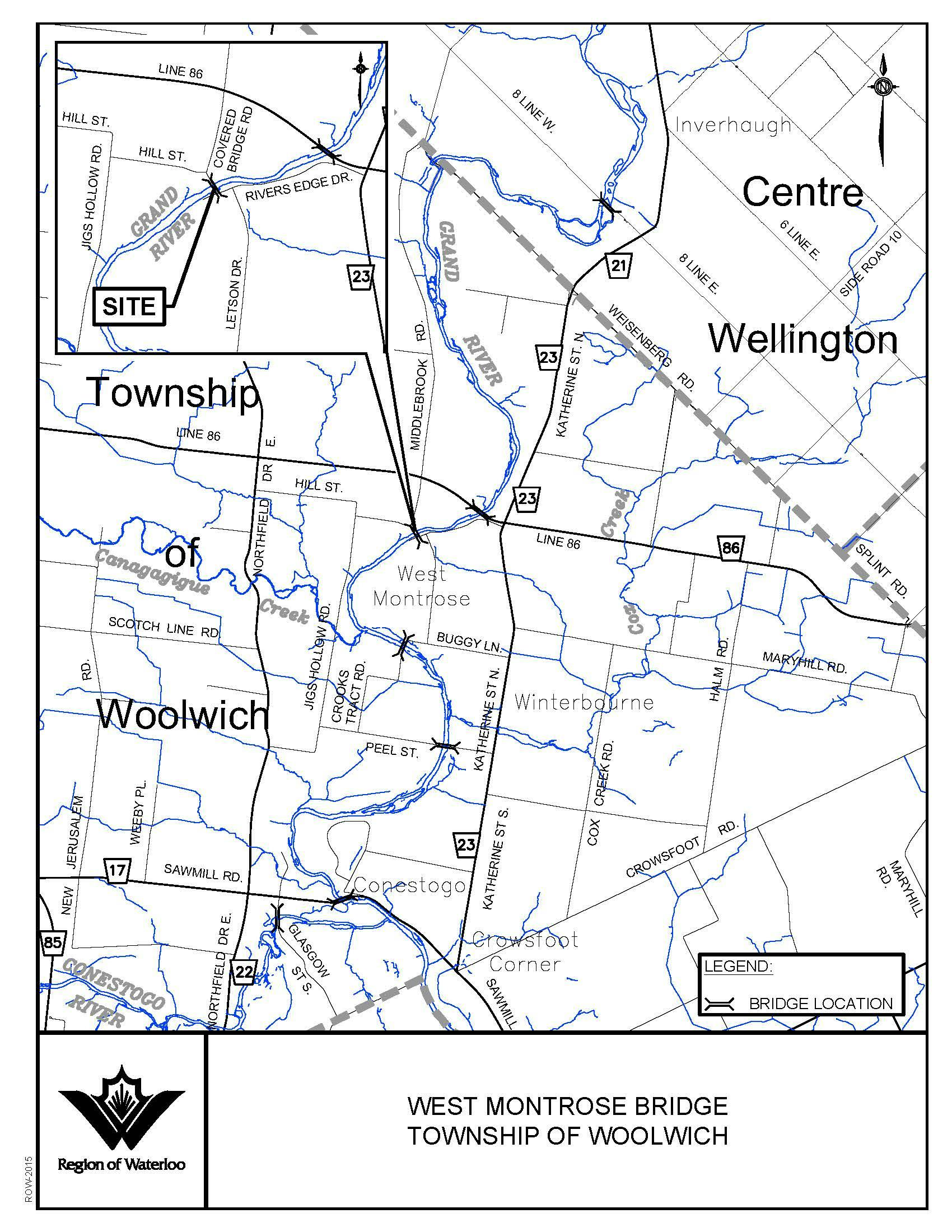West Montrose Covered Bridge Rehabilitation - Woolwich
This project supports the Region of Waterloo's strategic focus area(s):
![]()

The Region of Waterloo is looking to rehabilitate the West Montrose Covered Bridge in the Township of Woolwich through a major structural upgrade.
The project will follow a Schedule “C" Municipal Class Environmental Assessment, and stems from long-term monitoring and evaluation of the load-carrying capacity of the bridge.
A detailed inspection and evaluation of the timber truss was undertaken and recommendations were provided for the timber truss elements that require replacement due to deteriorated conditions. Six rehabilitation alternatives were reviewed against a set of evaluation criteria including heritage, structural, social environment and cost criteria to recommend the preferred alternative.
Recommended Design Concept
The Recommended Design Concept includes removal of the existing steel Bailey trusses, replacement of deteriorated wooden truss members and bridge elements, and reinforcing select members to accommodate a 10-tonne design vehicular live load. The three-tonne posted load limit will be maintained. To prevent oversized vehicles from accessing and damaging the bridge, an overhead height restriction bar is proposed on the north approach of the bridge and narrowing the road is proposed on the south approach.
The recommended design concept proposes the following:
- Reducing the existing sag on the bridge
- Replacing the roof with new cedar shingles
- Replacing the red exterior wooden cladding
- Replacing the window louvres
- Removing the existing steel Bailey truss
- Reinstating the tar and chip wearing surface after replacement of the nail-laminated deck
- Replacing the steel hanger rods inside the bridge
- Replacing the roof rafters as necessary
- Replacing the tie beams, as necessary
- Replacing the wooden curbs
- Replacing the interior light bulbs, as necessary
- Replacing the needle beams with new 16” x 16” Douglas fir beams
- Replacing the floor beams with new 16” x 16” Douglas fir beams
- Stone mortar repairs and placement of scour protection at the bridge pier
- Replacing the external sway bracing
- Replacing the stringers with new sawn wood stringers
- Replacing the existing nail-laminated wooden deck
- Removing the Bailey truss hanger system
- Removing the non-functioning tension rods (1959)
- Replacing the bottom lateral bracing
- Replacing the bottom chords with new Douglas Fir chords
- Repairing the concrete at the bridge abutments
- Keeping the same bridge deck elevation and approach grades
- Adding a height restriction bar to prevent heavy vehicles from using the bridge
- Using fire retardant materials on the timber truss elements and exterior cladding
- Replacing the end diagonals at the pier and strengthening of the end diagonals at the abutments
- Adding new overhead wood lateral bracing
- Adding a new timber guiderail
- Reinforcing the top chord with the lower top chord
- Removing the interior cladding and reinstatement in short sections at each end of the bridge
Items #1 to #25 are common to all of the alternatives that were considered. Items #26 to #30 are specific to the Preferred Alternative C2 – wooden truss repairs to a 10 tonne load limit.
The Recommended Design Concept was approved by Regional Council on February 21, 2024. Review the staff report.
The recommended design was the outcome of the technical studies conducted, a detailed alternatives assessment based on a set of evaluation criteria, and public input from three rounds of public engagement in October 2021, June 2022, and November 2023.
The recommended design addresses public concerns we heard such as the need for replacement truss members to be entirely with new wood members. The project team also revised the recommended design to include narrowing the road on the south approach of the bridge by moving the wooden guiderails closer to each other to eliminate the need for the height restriction bar on the south approach.
Based on the public feedback received, the project team is not recommending a restriction of all motorized vehicles on the bridge at this time.
The Environmental Study Report for this Schedule ‘C’ Class Environmental Assessment will be filed for a 30-day review period in Spring 2024. Construction is expected to start in 2025 and be completed in 2026.
Documents
The Preferred Alternative renderings can be found under the Public Consultation #3 folder to the right. A summary of Frequently Asked Questions (FAQs) and responses to comments received during the public consultation can be found on the right.



